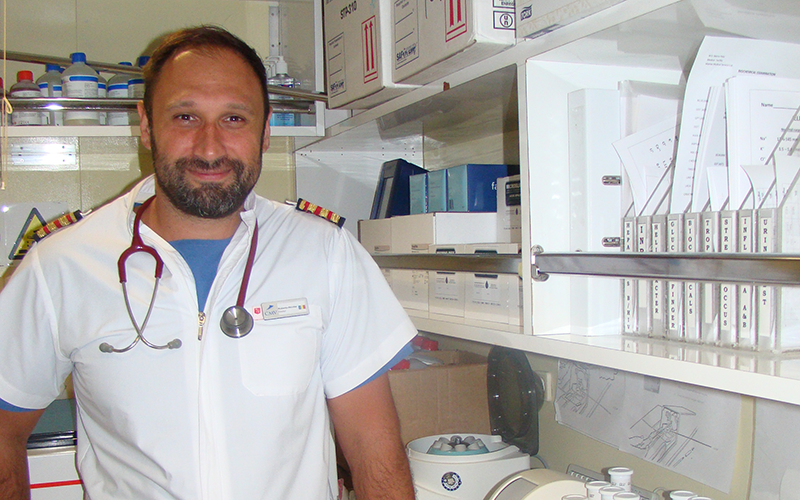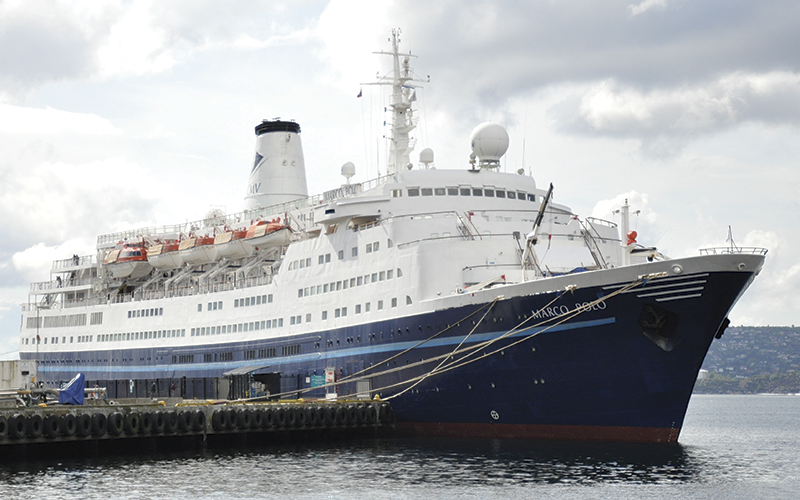What you can expect if you get ill on a cruise? John Bagshaw takes to the sea to find out.

Every year over 20 million people spend part of their lives (and more than £32bn) aboard “floating hotels”. They expect access to most of the facilities they would have on dry land, including medical resources.
The need is often greater than that of the average population, as cruising is a particularly popular form of holiday for the retired and elderly.
The confinement of hundreds (or even thousands) of people within an enclosed environment, drinking stored water, breathing conditioned air and consuming mass catering, makes these populations vulnerable to infectious agents, such as respiratory viruses and gastrointestinal pathogens.
How are the cruise liners able to manage and control these risks that threaten to spoil the exotic and relaxing experiences the passengers have paid for?
I spent over five weeks on board the Marco Polo, a 750-passenger cruise ship that was visiting the Amazon and West Indies, and was able to find out what lies behind the medical centre doors.
The Marco Polo is a classic ocean liner, built 50 years ago for the Soviet merchant fleet. Now, much updated, she belongs to Cruise and Maritime Voyages (CMV) who run cruises from UK ports around the world. She is an elegant ship to look at, and little betrays the elderly nature of some elements.
The engines are still the original twin seven-cylinder 21,000 hp two-stroke diesels from the 1960s. They are capable of driving the ship at 19 knots, or cruising at 15 knots for long periods. A crew of about 350 serves the passengers via two main restaurants, a range of bars and other facilities. We were travelling overnight every day except one, and when crossing the Atlantic we were a long way from port, so needed to be self-sufficient in medical support. A medical facility occupies part of a lower deck, and I visit to meet the Chief Medical Officer.

The marco polo
- First took to the sea in 1965 named The Aleksandr Pushkin with the Baltic Shipping Company, one of the three principal Soviet passenger shipping companies
- In 1993, following completions of the conversion, the Marco Polo cruised all over the world, and has been to South-East Asia, Africa, and Antarctica
- In July 2009, a health inspection found up to 150 passengers were discovered to have been infected with what was presumed to be norovirus.
- The ship is registered in the Bahamas and has a total of 425 cabins.
- It has eight passenger decks and four lifts.
Dr Roberto-Nicolas Teo’s training and early medical career were spent in his native Romania, and he graduated from the medical university in Bucharest.
After working in paediatrics and obtaining a degree in emergency and trauma care, he spent some time with the major emergency trauma unit, becoming Medical Director of the ambulance service before taking his current position as ship doctor on the Marco Polo.
He has worked on CMV ships for six years, and is looking forward to the end of his six-month stint with CMV, when he plans to return home to spend more time with his wife, seven-year-old son, three motorbikes and collection of freshwater stingrays (yes, really).
“We have to be able to deal with every situation,” he tells me, “as we are out of range of emergency transport for quite long periods. Helicopters can only reach a hundred miles or so. If we have a serious emergency, we may have to turn back or divert. It does not happen often. A couple of years ago, we were two days out at sea and a passenger became very sick. We were able to contact a local fishing boat and I accompanied the patient to port.”
Most situations can be diagnosed and dealt with on board. Dr Teo shows me the laboratory facilities and talks through the tests they can perform. “We have biochemistry for 14 parameters, plus a troponin/CK-MB/Myoglobin system, glucose by finger prick and haematology. For infections, we have a range of rapid test strips for flu, GAS and since 2015 even for Legionella. Norovirus is a great worry, and we have tests for that and for Salmonella/Shigella in case of outbreak. We have not had one for six years now.”
H. pylori tests and dipslides for culture of UTIs complete the laboratory tests, and for imaging he has an X-ray and an ultrasound facility. All of these resources are housed in small rooms and there is a single-room operating theatre where minor procedures can be performed and a recovery room. “We even have a mortuary, with room for three,” he says. “It has been filled only once in my time, on the way to Helsinki. The authorities came aboard and asked if we wanted to keep the bodies to take them back with us – I said ‘no way’, what if we have more?”
I ask what issues most often need to be dealt with on a cruise such as this. “Respiratory infections of one kind or another, and with an elderly population pneumonia is a high risk. We do not take any chances, so although antibiotic husbandry is important, we will use what we know will work first time if treating a 70-year-plus individual. At the same time as administering antibiotics, we will act to deal with potentially reduced immune systems. We will nebulise the patient and employ anti-inflammatories, check their white blood cell count and X-ray them.”
As we are to spend a week on the Amazon, I ask if he thinks that we should be taking anti-malarials. “Everyone asks that,” he says. “I have not seen a case of malaria in all the six years I have been on this ship. Some anti-malarials have unpleasant side effects – I don’t think they are worth the risk.”
I mention the prevalence of hand sanitisers on board – every visitor to the restaurants is greeted by staff with dispensers, and automatic units are stationed around the decks. “The ship is washed down twice a day,” he tells me, “and we use Virkon in cleaning procedures. Between cruises the rooms are all fogged”. It occurs to me that alcohol hand rubs don’t kill norovirus, I wonder out loud if the ones used on board were different. It is not a popular thing to say. The conversation moves on.
John Bagshaw is an in vitro diagnostics market specialist.




